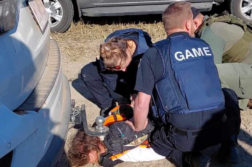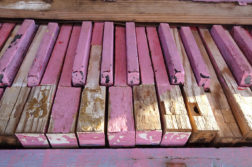It’s 44 degrees. A lone four-wheel-drive crawls through an empty street, a bright orange flag swinging at the top of its aerial. It’s emerged from the ochre-coloured sand dunes of the Simpson Desert into Birdsville, population roughly 100.
It’s the end of the tourist season — the weather is warming up, the charter pilots and seasonal hotel staff have left and the locals are preparing for a scorching summer. Unfortunately for these straggling tourists and those of the future, one of Birdsville’s best attractions, the Birdsville Working Museum, is now nothing but a faded, empty shed.
Since the museum closed in September, almost every tourist I have encountered has expressed disappointment, regret and sometimes even anger at the museum’s closure. But, after four years on the market with little interest from buyers, it’s understandable that the owners chose to close their doors. They’re in their mid-60s and looking forward to retirement.
Now, residents are looking towards the usually quiet summer with more trepidation than usual. How will the museum’s closure affect the 2012 tourist season? To the tiny town on the edge of the desert that largely survives on tourist dollars, the Birdsville Working Museum was an integral attraction.
Of course, there remains plenty of pull for tourists, especially those who come with their own transport — the drive to get here is an adventure in itself — as well as things like the "Big Red" sand dune. But, for the 20 or so tour companies that fly or bus into town, the museum was a major reason for staying an extra night, thereby injecting money into the pub, general store and other businesses.
Despite its financial importance, the museum is far more significant as a symbol of our cultural heritage. Its huge collection of primitive agricultural machinery gave visitors a glimpse into the hardship experienced and the ingenuity required by early outback settlers in a time of human toil and horsepower. By developing such machinery, as displayed at the museum, the tough, outback Aussie battler established the farming industry upon which our nation now relies.
The museum also housed an impressive, colourful array of biscuit tins, tobacco tins and medicine jars that were a reminder of a history of Australian manufacturing that is now nearly extinct. Many companies have dissolved, such as Swallow & Ariel Biscuits, or, in the case of Arnott’s, been sold to offshore parent companies.
Bridles, whips and barbed wire on display gave visitors a glimpse into leatherwork and fencing by hand, which is still practiced in rural areas today, and can be torturously difficult, particularly in the outback where fences are thousands of kilometres long.
The fact that there was little outside interest in saving the museum and its collection suggests that perhaps we, as Australians, should be concerned about lack of interest in our industrial history, particularly history of the outback and pastoral development.
Although the Australian Bureau of Statistics (ABS) reports that over two thirds of our population live in major cities, the outback features heavily in our collective history and sense of nationalism. For example, Waltzing Matilda, arguably our most well-known song, is set in early outback times. Birdsville, 1160 kilometers from the closest capital city, is as outback as you can get and is therefore a suitable place for a museum celebrating outback life.
But, when kids would rather go to Movie World than Mungerannie, and adults are saving for Europe rather than Uluru, we must question the importance of our pastoral heritage in the modern day Australian’s life.
Why should we care about the middle of nowhere when we have broadband, iPhones and LED TVs? Why should we drive for three days though a desert when we can fly to Bali for a few hundred bucks? Why should we care about an eclectic, out-of-the-way museum closing down when we have IMAX?
Because museums like the Birdsville Working Museum, and outback communities in general, are representative of both our history and what is an oft-forgotten, but essential, part of our survival to this day: farming. When packaged meat comes from neatly stacked supermarket shelves, it’s easy to forget that farming generates $155 billion-a-year in production and 93 per cent of Australia’s daily domestic food supply, according to the National Farmers’ Federation. The museum that recognises these farming achievements and teaches city-folk about the hardships of past and present outback life has disappeared, fading into Birdsville’s history.
Although it’s only one of a few similar museums in small towns around the country, such as Old Tailem Town near Tailem Bend in South Australia and Avondale Discovery Farm in Western Australia, sales terms also influenced its closure. It’s still uncertain how its absence will affect tourism in the area but already the museum is sorely missed. The big concern is that people will be likely to overlook an outback holiday now that there is one less thing to do here.
But, let me assure you, Birdsville is one of the many outback towns that are the heart and soul of our country. I didn’t realise until I lived here just how important it is to experience the diversity of Australian life as well as explore foreign shores. There’s a frog that lives in my toilet, the whole town gathers at the pub on Friday nights and Akubras are everyday wear — none of which happens in my hometown of Melbourne.
I can only hope that the closure of the Birdsville Working Museum isn’t indicative of people’s disinterest in the outback. I hope that it gives us a chance to reflect on how much importance we should place on learning about and experiencing our country, our history and the importance of rural industry.
Donate To New Matilda
New Matilda is a small, independent media outlet. We survive through reader contributions, and never losing a lawsuit. If you got something from this article, giving something back helps us to continue speaking truth to power. Every little bit counts.



